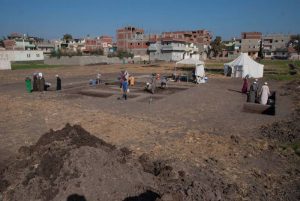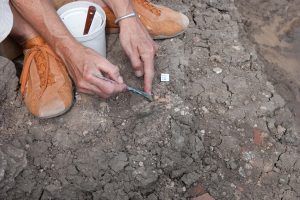Archaeologists discovered parts of a building complex as well as a mortar pit with children’s footprints at the ancient city of Pi-Ramesses at Qantir, North Egypt, which was the capital during the reign of the King Ramses II.

According to the researchers the building complex covers about 200 by 160 metres, indicating, together with the layout, that it was likely a palace or a temple. The structure was located through earlier geophysical measurements, involving magnetic survey of the area. The archaeologists’ aim is to locate a potential entrance to the monumental building, which seems not to be located as is typical in the axis of the complex, but rather in its north-western corner.

The archaeologists also found a a mortar pit extending to at least 2.5 by 8 metres, with children’s footprints preserved at the bottom. The filling of the pit consisted of smashed pieces of painted wall plaster, however no motifs are recognisable so far on them. According to the researchers, they are certainly remains of large-scale multi-coloured wall paintings.

(after Ahram Online, Egypt Independent & Pi-Ramesses mission)